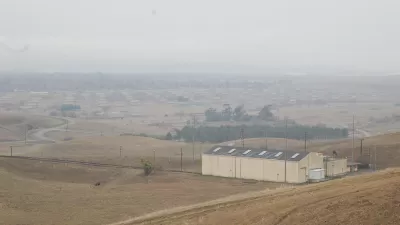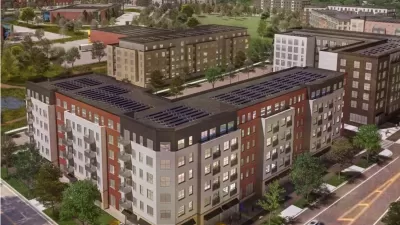The city of Concord, home to 130,000 but often neglected in the public consciousness of the San Francisco Bay Area, could set new standards for master planning practices.

John King provides a detailed update on one of the largest mega-development projects in Northern California right now—the $6 billion plan to convert a former naval weapons station to a master planned community including 13,000 homes, BART access, and a new approach to integrating a mix of uses into a new community.
"The potential canvas" for the project, writes King, "is the Concord Naval Weapons Station, a vast terrain dotted with trees and dozens of partially concealed ammunition bunkers."
"The emerging vision would place 13,000 housing units in structures ranging from multistory apartments above shaded colonnades to single-family homes on snug village greens. A transit corridor flanked by bicycle lanes would extend the length of the 3.4-mile-long site. Office buildings would cluster near the BART station at one end — parting to make room for a paseo-like footpath leading up to a ridgeline park."
While the project has been in works for the entire decade, a full plan and a draft environmental report are expected this winter, according to King, with a City Council vote on the project not likely for another year after that.
More than just providing details news coverage of the project, King also lends an assessment, as the San Francisco Chronicle's urban design critic, of the project's value to the city and the larger Bay Area. According to King, "in a region hobbled by the challenge of finding ways to add sizable amounts of housing in a manner that feels humane, the scenario in Concord offers heartening promise on a truly large scale."
In addition to the project's ability to deliver a large amount of housing in a supply constrained market, King also approves of how the planning and design details of the project are taking shape:
Plans at this stage often promise more than real life delivers. There’s no shortage of infill “placemaking” efforts in recent years that are hollow shells of their initial hype.
Nevertheless, it’s exciting to see a major firm focused on large-scale suburban futures — how to add density in a way that would take cues from its more settled surroundings while adding new layers to the scene.
FULL STORY: Concord weapons station has fraught history, but development concept has promise

Alabama: Trump Terminates Settlements for Black Communities Harmed By Raw Sewage
Trump deemed the landmark civil rights agreement “illegal DEI and environmental justice policy.”

Planetizen Federal Action Tracker
A weekly monitor of how Trump’s orders and actions are impacting planners and planning in America.

Why Should We Subsidize Public Transportation?
Many public transit agencies face financial stress due to rising costs, declining fare revenue, and declining subsidies. Transit advocates must provide a strong business case for increasing public transit funding.

Understanding Road Diets
An explainer from Momentum highlights the advantages of reducing vehicle lanes in favor of more bike, transit, and pedestrian infrastructure.

New California Law Regulates Warehouse Pollution
A new law tightens building and emissions regulations for large distribution warehouses to mitigate air pollution and traffic in surrounding communities.

Phoenix Announces Opening Date for Light Rail Extension
The South Central extension will connect South Phoenix to downtown and other major hubs starting on June 7.
Urban Design for Planners 1: Software Tools
This six-course series explores essential urban design concepts using open source software and equips planners with the tools they need to participate fully in the urban design process.
Planning for Universal Design
Learn the tools for implementing Universal Design in planning regulations.
Caltrans
Smith Gee Studio
Institute for Housing and Urban Development Studies (IHS)
City of Grandview
Harvard GSD Executive Education
Toledo-Lucas County Plan Commissions
Salt Lake City
NYU Wagner Graduate School of Public Service





























